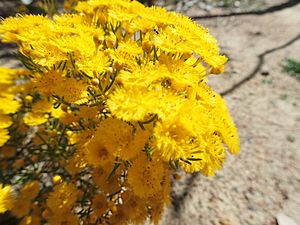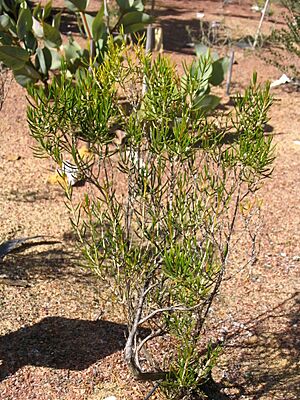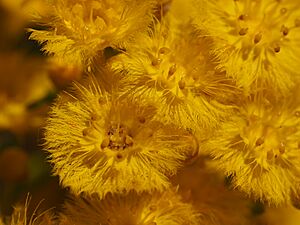Verticordia galeata facts for kids
Quick facts for kids Verticordia galeata |
|
|---|---|
 |
|
| Verticordia galeata growing in Kings Park | |
| Conservation status | |
| Scientific classification | |
| Genus: |
Verticordia
|
| Species: |
galeata
|
Verticordia galeata is a beautiful flowering plant from the myrtle family, called Myrtaceae. This special plant only grows in the south-west part of Western Australia. It's a woody shrub, which means it has a strong, woody stem.
This plant has thin, pointed leaves that look like small cylinders. In spring, you can see bright yellow flowers grouped together at the ends of its branches. It's a lovely sight!
Contents
What Does Verticordia galeata Look Like?
Verticordia galeata is a shrub that can grow up to about 1 m (3 ft) tall and wide. It has branches that spread out in different directions. Its leaves are long and thin, almost round, and are about 10–30 mm (0.4–1 in) long with a pointy tip.
The flowers of this plant smell like honey. They grow in groups near the ends of the branches. Each flower sits on a straight stalk that is about 12–20 mm (0.5–0.8 in) long. The part of the flower that holds the petals and sepals, called the floral cup, is shaped like half a ball. It's about 2 mm (0.08 in) long and feels a bit bumpy.
The sepals, which are like small leaves that protect the flower bud, are bright yellow and spread outwards. They are about 5 mm (0.2 in) long and have 7 to 9 fuzzy parts. The petals are also bright yellow and stand upright. They are about 5 mm (0.2 in) long and have long, finger-like parts that spread out.
This plant has special parts called stamens, which make pollen. They have a puffed-up cover that almost hides their tips. The style, which is the part that receives pollen, is straight and about 2.5–3.7 mm (0.098–0.15 in) long. You can see these flowers from September to November.
Verticordia galeata looks a bit like other plants such as V. chrysantha and V. chrysanthella. However, you can tell it apart because its leaves are longer, its flower stalks are longer, and its bright yellow flowers do not fade in color.

How Was Verticordia galeata Named?
The plant Verticordia galeata was first officially described by a scientist named Alex George in 1991. He wrote about it in a science journal called Nuytsia. He found the first samples of this plant near the Murchison River in Kalbarri National Park.
The second part of its name, galeata, comes from a Latin word. Galeatus means "helmeted." This name probably refers to the special, helmet-like cover on the stamens of the flower.
Where Does Verticordia galeata Grow?
There are only a few places where Verticordia galeata is known to grow. These small groups of plants are found in red sand, often among sandstone cliffs. They grow in open scrublands around the lower Murchison River. This area is in the northern part of a region called the Geraldton Sandplains.
Protecting Verticordia galeata
The Western Australian Government's Department of Parks and Wildlife has listed Verticordia galeata as "Priority Two." This means that not much is known about the plant, and it only grows in a few places.
This plant does not have a special underground stem called a lignotuber. This means it cannot easily regrow after a fire. So, it is very sensitive to changes in how often fires happen. Luckily, it grows inside Kalbarri National Park, which is a protected area. However, even in the park, strong fires can still be a threat to this special plant.
Growing Verticordia galeata in Gardens
People sometimes grow Verticordia galeata in gardens because its flowers last a long time. They are also very bright and smell sweet, making them attractive garden plants. Gardeners can grow new plants from small pieces of the plant, called cuttings. They can also join a piece of Verticordia galeata onto the roots of another plant, like Darwinia citriodora. This is called grafting.
Once they are growing well, these plants like lots of sunshine and soil that drains water easily. Some have even grown well in places that get a lot of rain in winter.



